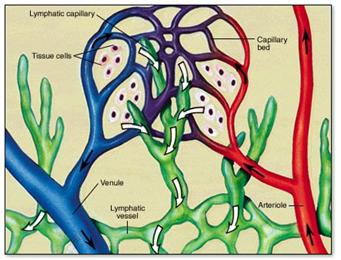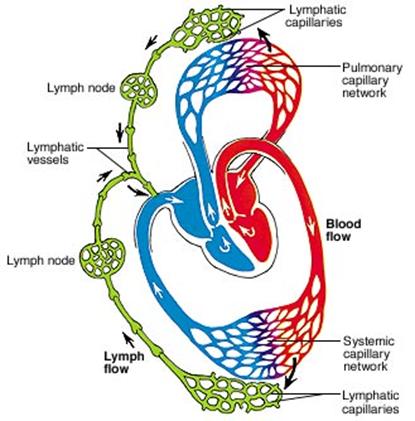
| Home | LYMPHATIC SYSTEM |
DEFINTION OF THE LYMPHATIC SYSTEM
The lymphatic system is a network of cells, tissues, tubes that helps in the transportation of fluid known as lymph from interstitial species to the blood stream in the body.
Differences between blood circulatory system and the lymphatic system
| ITEM/PROCESS | BLOOD CIRCULATORY SYSTEM | LYMPHATIC SYSTEM |
| Path | Complete circuit | One way flow |
| Pumping organ | Heart | None |
| Vessels | Blood vessels | Lymphatic vessels |
| Fluid | Blood plasma | Lymph |
| Protection | White blood cells | Lymph nodes |
Functions of the lymphatic system
Some of the functions of the lymphatic system are:
Transportation of lymph- fatty acids and glycerol.
Protection of the body- The lymph nodes produces lymphocytes that protect the body from diseases.
Components of the lymphatic system
The lymphatic systems comprised of the following components are:
1. Lymphatic vessels
2. Lymph
3. Lymph nodes
1. Lymphatic vessels
The lymphatic vessels are similar to the arteries and veins of the blood circulatory system. However, we can say they are of two types only:
- Lymphatic vessels
- Lymphatic capillaries
- Lymphatic vessels
The lymphatic vessels collect the lymph from the capillaries of interstitial spaces of the organs of the body and pour it into the systemic circulation. The lymphatic vessels have valves similar to that of the veins. These valves help in preventing the reflux of the lymph.
2. Lymphatic capillaries
The lymphatic capillaries are microscopic ends of the lymphatic vessels similar to the venules or arterioles. They terminate in the capillaries of the organs of the body.

Figure: Relationship between lymphatic system and the Blood circulatory system 1
2. Lymph
The lymph is the liquid component of the lymphatic system. It comprised of the water and product of lipid digestion- fatty acids and glycerol.
3. Lymph Nodes
Lymph nodes also referred to as Lymph glands are small swellings located along the lymphatic pathways. The lymph nodes produce lymphocytes and macrophages that protect the body from illnesses. The lymph nodes help in filtering the lymph before it is drain into the systemic system.
How the lymphatic system works?
Basically, the lymphatic system collects fluid known as lymph from all the interstitial species in the various organs of the body into the main blood stream.
The right lymphatic duct collects lymph from the upper part of the body and drains it into the systemic circulation. While the thoracic ( left hepatic duct) collects lymph from the rest of the body and drains it into the systemic circulation.

Figure: Relationship between lymphatic system and the Blood circulatory system
| PREV | NEXT |